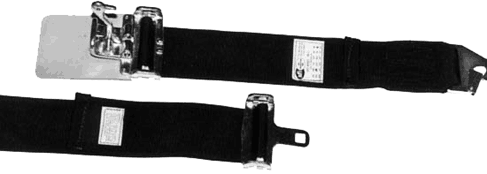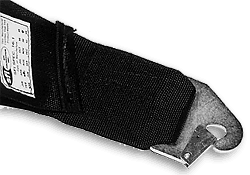
G-FORCE & BARREL ROLLS
There's something else that's very important.
Bob Stroud (Stroud Safety Equipment) calls it
the worst possible accident scenario if the
car barrel rolls multiple times. G-forces can
become incredible in an accident of that sort.
The worst possible end to this situation is
where a car does the barrel roll(s) and then
comes to a very quick and short stop. In these
situations, the g-forces can exceed 40 (the
limit of human tolerance is being approached
at about 50 g). Unfortunately, some people become
seriously injured in racing accidents involving
far less energy.

When looking at the lap
belt, keep a couple of things in mind. First,
two-inch lap belts are no longer legal in most
forms of racing. The increased area of webbing
which a three-inch wide belt provides increases
strength dramatically, but it also distributes
the forces present in a crash over a much larger
area. Also evident in this photo is the webbing
that is sewn in place with an incredibly strong,
government-approved
nylon thread.
WEBBING STRENGTH
Consider how a seat belt is constructed. The
belt webbing is sewn in place with an incredibly
strong nylon thread, but even the strongest
thread or webbing will begin to break down with
age, exposure to the elements, misuse, exposure
to chemicals, exposure to perspiration along
with a host of other factors. And these factors
add up. A conservative estimate in regard to
belt condition shows that belts can lose as
much as 30% of their webbing strength in two
short years. That's why sanctioning bodies mandate
the replacement of belt webbing at a regular
interval.
 |
Snap-in ends on seat belts
are perhaps the easiest to use for drag
racing. Basically, a high strength forged
steel eyebolt (designed and manufactured
specifically for this application) installs
in the floor of the car. As you can well
imagine, the snap-in end, eyebolt combination
can simplify mounting in some cars. It also
helps when servicing and inspecting belts. |
Snap-in ends on seat belts are perhaps the
easiest to use for drag racing. Basically, a
high strength forged steel eyebolt (designed
and manufactured specifically for this application)
installs in the floor of the car. As you can
well imagine, the snap-in end, eyebolt combination
can simplify mounting in some cars. It also
helps when servicing and inspecting belts.
WHAT DO YOU NEED?
There are three common methods of mounting
a set lap belts or shoulder harnesses. Included
are snap-in, bolt-in and "wrap around" versions.
The snap-in system consists of a special spring-loaded
hook that attaches to an eyebolt. Typically,
the eyebolt is very strong forged steel piece
designed specifically for this application.
With a bolt-in, the hardware simply bolts to
a mount in the vehicle. Although this arrangement
sounds simple enough, most manufacturers advise
that the end fitting must be installed at an
angle that is compatible with the direction
of pull on the webbing under full load (mount
the belt hardware in shear with the direction
of the belt pull). The mount hardware must not
be installed at a right angle (perpendicular)
to the belt!
Wrap around hardware is designed to wrap around
a section of chassis or roll cage tubing. Once
wrapped around the tubing, the belt is secured
with a three bar slide adjuster. Some sanctioning
bodies require that wrap around installations
be secured with two of these adjusters per belt
end.

|